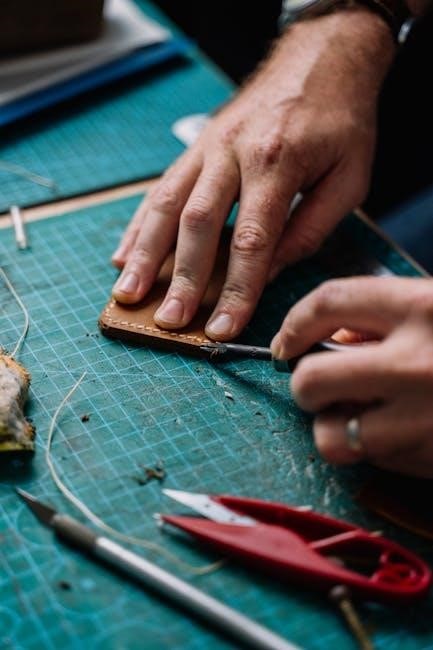
making a murderer viewing guide
“Making a Murderer” is a gripping Netflix series exploring the Steven Avery case, raising questions about justice, police misconduct, and the impact of true crime storytelling.
Background and Overview
“Making a Murderer” is a true-crime documentary series that examines the case of Steven Avery, a man wrongly convicted of murder, then accused again after his release. The series explores his legal battles, raising questions about justice, corruption, and the reliability of the criminal justice system. Its gripping narrative has sparked widespread debate and public interest.
Purpose and Creators
Created by Laura Ricciardi and Moira Demos, “Making a Murderer” aims to explore the complexities of the criminal justice system through Steven Avery’s case. The filmmakers spent over a decade documenting his legal battles, seeking to uncover truths and spark dialogue about systemic issues, justice, and the impact of real-life events on individuals and society.

Key Figures in the Documentary
The documentary centers around Steven Avery and Brendan Dassey, highlighting their legal struggles and the roles of their defense attorneys, Dean Strang and Jerry Buting, and prosecutor Ken Kratz.
Steven Avery
Steven Avery, a Wisconsin man, gained national attention after being wrongly convicted of rape in 1985 and later exonerated by DNA evidence in 2003. His fight for justice led to the Exposure of police misconduct. However, he was again accused of murder in 2005, raising questions about his guilt and the fairness of the legal system.
Brendan Dassey
Brendan Dassey, Steven Avery’s nephew, was convicted of murder based on his coerced confession. His case highlights issues with interrogation techniques and the reliability of confessions from individuals with intellectual disabilities. Dassey’s story in the documentary sparks debate about his culpability and the fairness of his treatment within the justice system.
Dean Strang and Jerry Buting
Dean Strang and Jerry Buting, Steven Avery’s defense attorneys, played pivotal roles in the documentary. Their dedication and strategic arguments highlighted the complexities of the case, showcasing their commitment to justice. Their calm demeanor and sharp legal insights made them compelling figures, drawing admiration from viewers and underscoring the challenges of defending high-stakes cases.
Ken Kratz
Ken Kratz, the special prosecutor in Steven Avery’s case, became a controversial figure due to his aggressive tactics and public statements. His handling of the trial raised questions about bias and the pursuit of justice, making him a focal point of criticism in the documentary and among viewers, who often questioned his impartiality.

Themes and Issues Explored
The series delves into false accusations, police corruption, and the failings of the justice system, sparking debates on fairness and ethical practices in criminal investigations.
False Accusations and Justice System
The documentary highlights the alarming issue of false accusations and their devastating impact on individuals like Steven Avery. It questions the reliability of evidence and confessions, particularly Brendan Dassey’s, raising concerns about coercion and mishandling of justice. The series underscores systemic flaws, suggesting that the pursuit of convictions may sometimes override the pursuit of truth, leaving viewers questioning the fairness of the legal system.
Police Misconduct and Corruption
The series sheds light on alleged police misconduct, suggesting Steven Avery was framed, with key evidence potentially planted. Coercive interrogation tactics and questionable handling of physical evidence raise concerns about corruption. The documentary portrays a system where law enforcement may prioritize securing convictions over uncovering the truth, undermining public trust in authority and the fairness of investigations.
Impact on the Community
The case deeply divided Manitowoc County, with some residents standing by Avery and others condemning him. The documentary sparked debates about justice, creating tension within the community. Local businesses faced scrutiny, and the reputation of law enforcement was tarnished, leaving lasting emotional and social scars on those involved and the broader public.
Evidence and Controversies
The series examines disputed evidence, including DNA results and questionable confessions, highlighting legal inconsistencies and raising doubts about the reliability of the prosecution’s case.
Physical Evidence Analysis
The documentary scrutinizes the handling of physical evidence, such as DNA and blood samples, questioning their authenticity and integrity. Controversies arise over potential evidence tampering and inconsistencies in forensic results; The series highlights how these issues undermine the credibility of the prosecution’s case, raising suspicions of misconduct and manipulation of key evidence;
Confessions and Reliability
The series examines the reliability of Brendan Dassey’s confession, questioning its voluntariness and the tactics used by interrogators. Critics argue that Dassey’s intellectual limitations and suggestibility made him prone to coercion, raising serious ethical concerns about the use of his statements in court and the potential for false confessions in criminal cases.
Digital Evidence Debate
Digital evidence, such as phone records and computer data, played a pivotal role in the case. However, debates arose over its interpretation and authenticity. Critics questioned whether investigators planted or mishandled digital evidence, particularly in Steven Avery’s case, highlighting concerns about the reliability of forensic technology and its potential misuse in securing convictions.
Public Reaction and Debate
The series sparked intense public debate, with viewers divided on Avery’s guilt and the fairness of the justice system, fueling widespread discussion and petitions for his exoneration.
Viewer Response and Opinions

Viewers of “Making a Murderer” expressed strong opinions, with many believing Steven Avery was wrongly convicted. Others questioned the documentary’s bias, sparking debates about justice and media influence. The series ignited empathy and outrage, prompting discussions on social media and calls for reform in the criminal justice system.
Impact on Public Perception
The documentary significantly altered public perception of the criminal justice system, highlighting potential corruption and bias. Viewers began questioning the reliability of law enforcement and the fairness of trials, leading to broader skepticism and demands for systemic change. The series also sparked empathy and outrage, fueling debates about justice and accountability in high-profile cases.

Ethical Considerations
The series raises ethical concerns about balancing storytelling with justice, questioning the portrayal of real people and its influence on public opinion and legal proceedings.
Storytelling vs. Justice
The series blurs the line between entertainment and real-life justice, raising ethical questions about how true crime documentaries impact legal proceedings and public perception. By presenting a narrative, the filmmakers risk swaying opinions, potentially influencing justice. This tension highlights the challenge of balancing compelling storytelling with the gravity of real lives and legal outcomes, sparking debates about bias and manipulation.
Portrayal of Real People
The documentary raises concerns about how real individuals, like Steven Avery and Brendan Dassey, are portrayed. Critics argue that the series often favors a narrative over objective truth, potentially skewing public opinion. This selective portrayal can deeply impact the lives of those involved, highlighting ethical dilemmas in presenting real people in a dramatic, edited format for public consumption and entertainment.
Influence on Public Opinion
“Making a Murderer” sparked intense public debate, with many viewers questioning the fairness of the justice system. The series influenced opinions, dividing the audience between those who believed Avery was wrongfully accused and others who supported the prosecution. This polarized reaction highlights the documentary’s power to shape perceptions and ignite widespread discussion about real-life criminal cases and their handling by authorities.
Viewing Tips
Engage actively by pausing for discussion and analyzing evidence. Take notes on key details to better understand the complex case and its emotional depth.
Engagement Strategies
To enhance your viewing experience, consider discussing theories with others, pausing to analyze clues, and reflecting on the ethical implications. Viewing guides suggest taking notes on key evidence and timelines to track the complex narrative. Encourage debates about guilt, innocence, and systemic issues, fostering a deeper understanding of the case and its broader societal impact;
Active Viewing Techniques
Engage deeply with “Making a Murderer” by critically examining each episode. Pay attention to inconsistencies in testimonies and evidence presentation. Question the credibility of sources and motivations of key figures. Reflect on how the documentary shapes your perceptions, separating facts from narrative bias. This approach enhances understanding and fosters informed discussions about the case and its implications.
“Making a Murderer” leaves viewers reflecting on justice, truth, and the complexities of the criminal system, sparking debates and lingering questions about the case’s outcome and implications.
“Making a Murderer” leaves viewers reflecting on justice, truth, and the criminal system’s flaws. The series sparks debates about Steven Avery and Brendan Dassey’s guilt, highlighting false accusations and police misconduct. Its emotional depth and controversial themes resonate deeply, encouraging audiences to question the fairness of the legal system and the human cost of seeking justice.
Final Thoughts and Impact
“Making a Murderer” has left a lasting impact on public perception of the criminal justice system. It sparked widespread debate, calling attention to potential corruption and the importance of ethical storytelling. The series not only changed Steven Avery and Brendan Dassey’s lives but also influenced how audiences engage with true crime narratives and question the reliability of legal processes.
Related Posts

scouts guide to the zombie apocalypse boob
Discover the ultimate zombie survival tips and hilarious adventures with the scouts! Your go-to guide for apocalypse prep and laughs.

th3210d1004 installation guide
Learn how to install your TH3210D1004 with our comprehensive, easy-to-follow guide. Get your device up and running effortlessly!

nami waiver guide
Discover the ultimate Nami Waiver Guide, packed with step-by-step instructions and expert tips to help you navigate the process effortlessly. Get approved faster with our comprehensive guide.